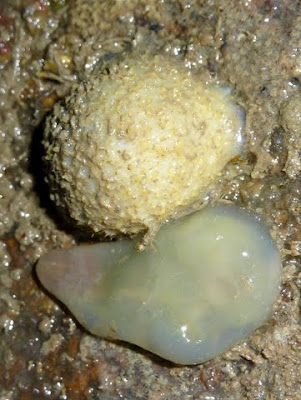On thursday late afternoon and evening, the monsoon rain poured over the whole of Singapore but that did not stop Geraldine and myself from having a look at the shore of Pasir Ris. I have not visited this shore for a year!
Drizzling and raining while I first arrived, I saw a long line of blue floating buoys stretching across the whole of the Pasir Ris coast.
Also seen is the No swimming signboard due to high bacteria levels in the water.
The long chain of floating barrier consists of many blue containers or buoys strung together. They were about 50m off the beach in the waters.
That aside, when I stepped on the shore, a heart-breaking scene struck me. What used to be lush seagrasses on the shore is now filled with many dug up holes. Ria has also previously documented this before on her blog.
So is Pasir Ris shore dead with all these impacts? The answer is no! :) Our marine life are very tough and resilient.
What a delight to spot many sea stars during the trip! A stunning orange Cake sea star (Anthenea aspera) and also a juvenile Biscuit sea star (Gonodiscaster scaber).
The orange Cake sea star was not the only one saw during the trip. There were three more of the same species that we came across that evening!
That's not all, it was nice to also see a huge Biscuit sea star as well. This sea star was found beside a green sponge.

The most abundant sea star species of Pasir Ris shore will still be the Plain Sand stars (Astropecten indicus). I'm glad they are still quite a good number of them, comparable to the past.
The only sea cucumber species that we saw will be the Ball sea cucumber (Phyllophorus sp.). I saw many of them at one particular spot only. Weird isn't it... do they aggregate like their sea urchin or sea star relatives?

Unlike undisturbed shores such as Chek Jawa, it is not common to find Haddon's carpet anemones (Stichodactyla haddoni) on mainland shores like Changi and Pasir Ris.
Another anemone that we came across will be a couple of these stranded Swimming anemones (Boloceroides mcmurrichi). When in the water, they are able to pulsate its body and tentacles to swim.
From far, I thought this was a weird unknown sea anemone. Upon a closer look, this was actually a Striped bead anemone with its body column exposed out. Quite interesting to see some sand stuck on the column. This anemone somehow sensed my presence through my torchlight and went burrowing back into position. Hehe!
On the murkier side of the water, there was this anemone that I was clueless to its identity. Anyone who can help to id?

On seagrasses and rocks, there are some growths of sponges of different species and colours. Many of which are branching in their growth form.
This yellow spiky ball is probably also a sponge. It is likely a Prickly ball sponge (Tethya robusta). The one below is a sea squirt or an ascidian.
Probably due to the rain, this Spearer mantis shrimp (Harpiosquilla sp.) was not really moving much!

Same too for these two Moon crabs (Family Matutidae). I think the mantis shrimp and moon crabs should be able to recover after some time since they have an exoskeleton as a layer of protection from freshwater, unlike soft bodied invertebrates.
I'm not too pro in taking photos of fishes and especially mudskippers since they will swim or skip away very quickly. Surprisingly, this mudskipper was quite obedient, or probably just blur that it didn't skip away despite me coming quite close to the fellow.
Last but not least, I came across this humongous jelly and blob-like structure stranded on the shore. After probing with a stick, this structure seems to be like a hardened jelly. It has the shape of a jellyfish. Could it be one?
Here's a closeup of this unknown creature/structure.
In the middle of the trip at night, a huge barge came to the shore and landed. An excavator on the barge began dredging and digging. That probably explains the holes I saw earlier. It could be the massive beach construction since Nov 09 and which is supposed to have finished by Aug 10. Hope that the marine life here recover after all these works have been done.
It was amazing that both of us could carry on the trip despite the lightning shows in the distance, rain and occasional wind. Thank God that the weather did not turn really bad.
More photo of this trip here: http://www.flickr.com/photos/koksheng/archives/date-taken/2010/11/25/
Sunday, November 28, 2010
Back to Pasir Ris shore
Subscribe to:
Post Comments (Atom)





















1 comment:
Wow, I think the mudskipper is the Blue-spotted mudskipper. I haven't got that down for Pasir Ris yet on wild facts! Great sighting and great shot!
Post a Comment